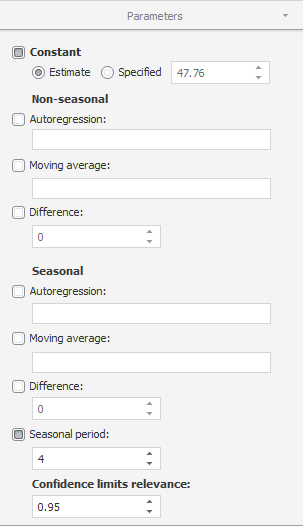 To apply the method
To apply the methodSeries values are modeled using the ARIMA method. It is included in the Forecast group.
The ARIMA model is one of the most popular methods that is used to make short-term forecasts.
After the method is applied, in the workbook, based on each selected series a calculated series with a name of the ARIMA(<Series_Name>) type is created, containing the calculation results. For example:

To set up calculation parameters, use the Parameters side panel tab.

Method parameters:
Constant. If the checkbox is selected, the model uses a constant. Specify the calculation method for the constant:
Estimate. The constant value is estimated automatically on method calculation. The value is displayed in the input box to the right.
Specified. The constant value is specified by the user in the corresponding box.
Non-Seasonal or Seasonal Parameters. Specify non-seasonal or seasonal method parameters:
Autoregression. By default this checkbox is deselected. If the checkbox is selected, the specified order of the non-seasonal or seasonal autoregression is taken into account.
Moving Average. If the checkbox is selected, the specified order of non-seasonal or seasonal moving average is taken into account.
TIP. Enter numbers or ranges of the moving average and autoregression order divided by commas. Specify order range using the - sign. For example: 1-3,5,7-9. In the desktop application, use the Parameters of ARMA Estimation side panel tab to set up autoregression or moving average parameters.
Difference. If the checkbox is selected, the specified order of differentiating non-seasonal or seasonal series component is taken into account.
Seasonal Period. The length of a seasonal period (for example, four quarters or twelve months).
Confidence Limits Relevance. Set the importance level of confidence limits for a forecast series. Available values range: [0; 1]. The default value is 0.95.
See also:
Working with Calculated Series | ARIMA | Modeling Container ARIMA